-
Car Reviews
- All reviews
- Midsize SUVs
- Small cars
- Utes
- Small SUVs
- Large SUVs
- Large cars
- Sports SUVs
- Sports cars
- Vans
Latest reviews
- Car News
-
Car Comparisons
Latest comparisons
- Chasing Deals
The RS3, powered by its screaming five-cylinder, is set to leave history on a high note, but is Audi asking too much to punch the ticket on the way out?
Once a common fixture of Mercedes-Benz, Volvos and even in Ford Rangers, five-cylinder engine availability has now been whittled down to just one option: the high-performance Audi RS3.
This midlife update may be the last we ever see for Audi’s hyper hatch as the stranglehold of international, and now national, emissions regulations close around the exhaust pipes of the RS3’s high-performance, and heavy-emitting, inline-five.

A possible hiatus, electrification and inevitably faster performance figures will follow in any potential RS3 successor, but for many Audi fans, the buck stops with the five-cylinder engine.
The update has brought no changes to the 294kW/500Nm outputs of the 2.5-litre engine, or improved its 3.8-second 0-100km/h time, but tweaks to the algorithm that rules the RS3’s trick all-wheel-drive system have made it corner faster and more aggressively, says Audi.
It’s these changes, along with a sprinkling of updates to exterior design and interior feature set, that Audi hopes will justify its near ten-grand price increase to its customers. The list price for its cheapest ‘RS’ is now well over $100,000.

Thankfully for Audi, Aussies are huge fans of the RS3, with our country collecting the fifth-highest sales in the world in 2024, despite our relatively small population.
“We want to keep [RS3] for as long as we can”, Jeff Mannering, director of Audi Australia, told Chasing Cars. With that sort of popularity with Aussie performance fans, we’re not surprised.
Audi’s RS3 is the most premium version of the A3 and S3 series vehicles and comes with a hearty specification list to match.
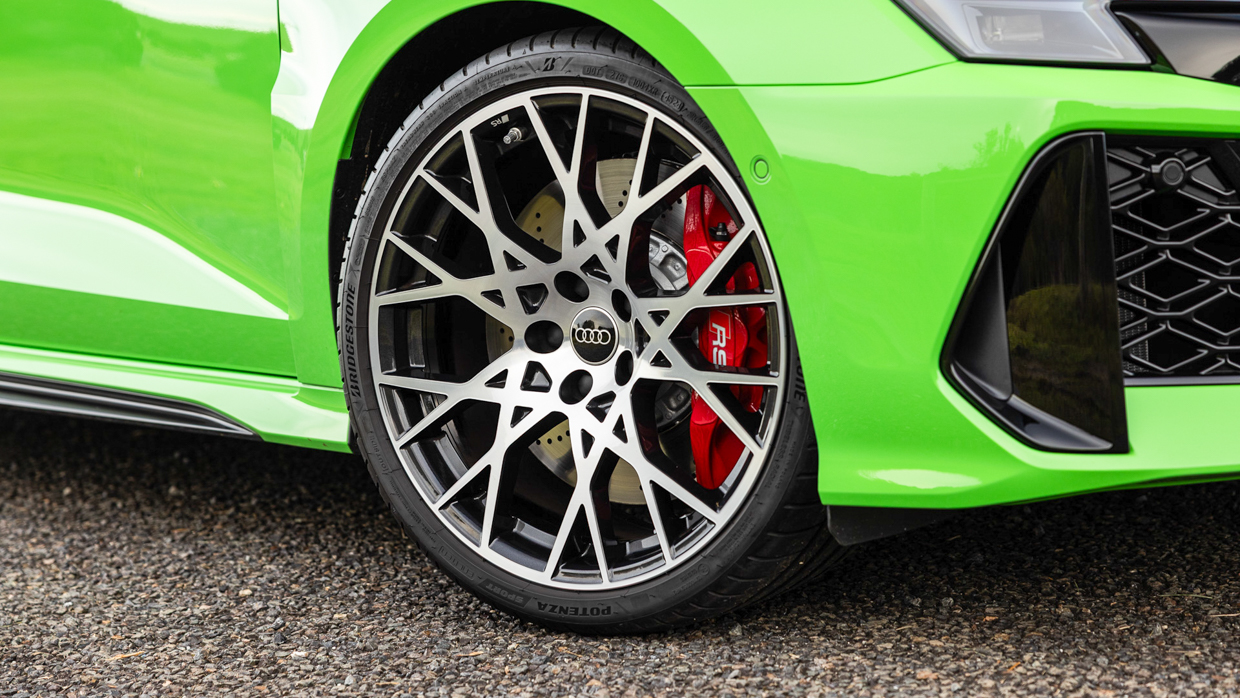
Standard features for the RS3 lineup includes:
The Sportback (hatch) is now priced from $104,800, and the sedan $107,800 before on-road costs. Those are big numbers, but for context, the equivalent Mercedes-AMG A45 and CLA45 S models are priced at $122,500 and $129,300, respectively, in their sole Edition R+ grades.
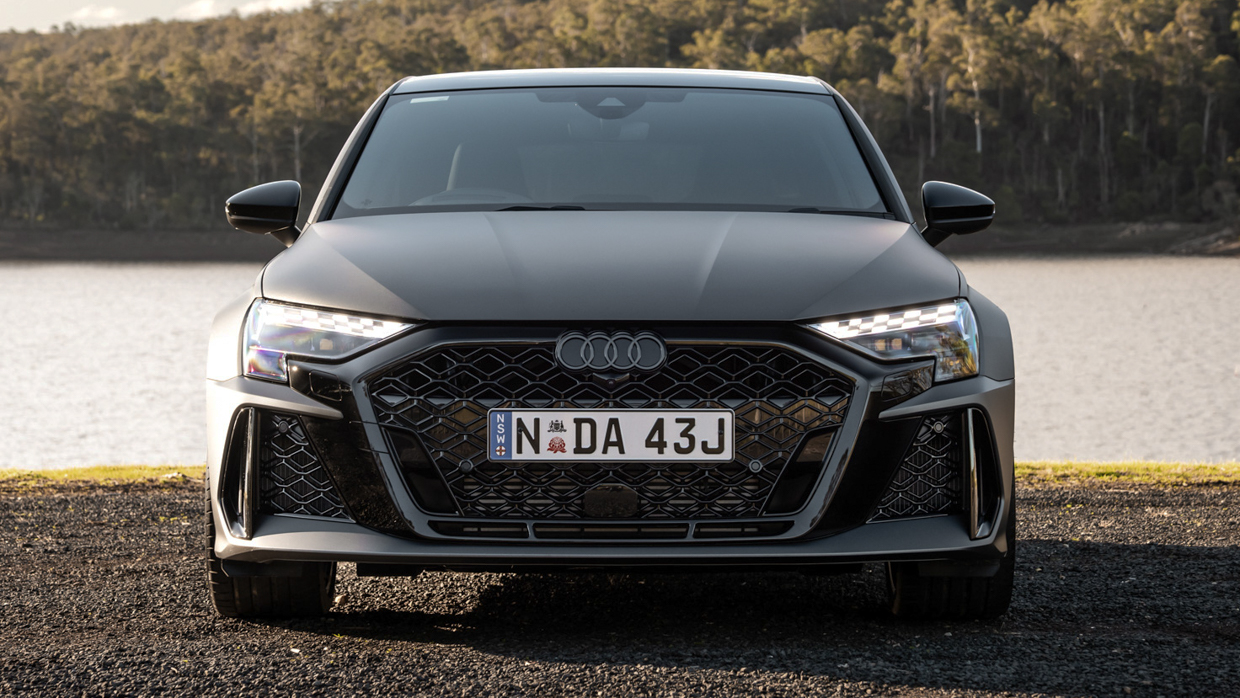
New to the RS3 is the option for Matte paint for an extra $11,400, with features such as ceramic brakes also available for an additional $10,800.
An exterior carbon package is available from $6300, while the RS Design Package Plus adds additional styling elements to the interior in either green or red for $2150.
There wasn’t a lot wrong with the way the pre-facelift RS3 drove, with the intention of this latest update being a general improvement of the ride and handling, while capitalising on the performance potential.
The arrival of the latest generation RS3 in 2022 marked a huge step forward for its handling ability. No longer restricted to just being a straight-line hammer, the RS3 became more adjustable and more capable when asked.
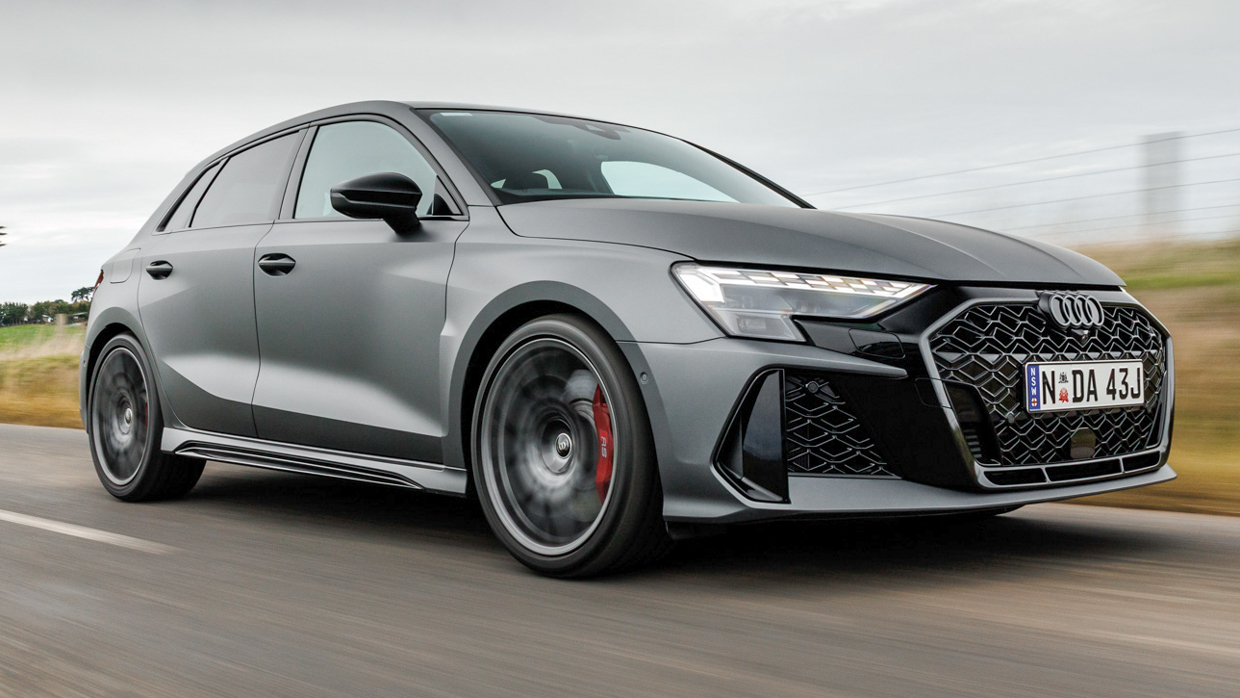
Audi’s brilliant electronically controlled twin-clutch limited-slip rear differential, which has now flowed down to the S3 and the related Volkswagen Golf R, added a welcome element of hooliganism with its dedicated Drift Mode.
All of this still remains in the updated model, but this time, there were no skid pans at the Australian launch; rather, it was a combination of pockmarked country roads and a tightly woven circuit to evaluate the RS3’s upgraded abilities.
Starting up the RS3 reveals a more aggressive note than before, thanks to higher RPMs at idle, though the neighbour-conscious among you should note the volume can be damped via drive modes in the touchscreen, linked to the valved exhaust system.

Some downsides of performance car living are still evident around town, with the thin rubber wrapped around the 19-inch wheels hiding little speed-bump-induced abuse, and the seven-speed dual-clutch transmission occasionally hesitating at low speeds, particularly on hills.
Even still, the RS3 remains delightfully nimble and easy to weave around town via its progressive steering rack, and the stop-start system is smooth when taking off from the lights. Despite its wide haunches and high-speed intent, the 2.5L engine and the RS3 as a whole feels relaxed for a hot hatch.
Audi engineers changed no physical components of the suspension in the latest retune, but the end result is impressive, particularly on Victorian country roads, which we explored in greasy conditions.
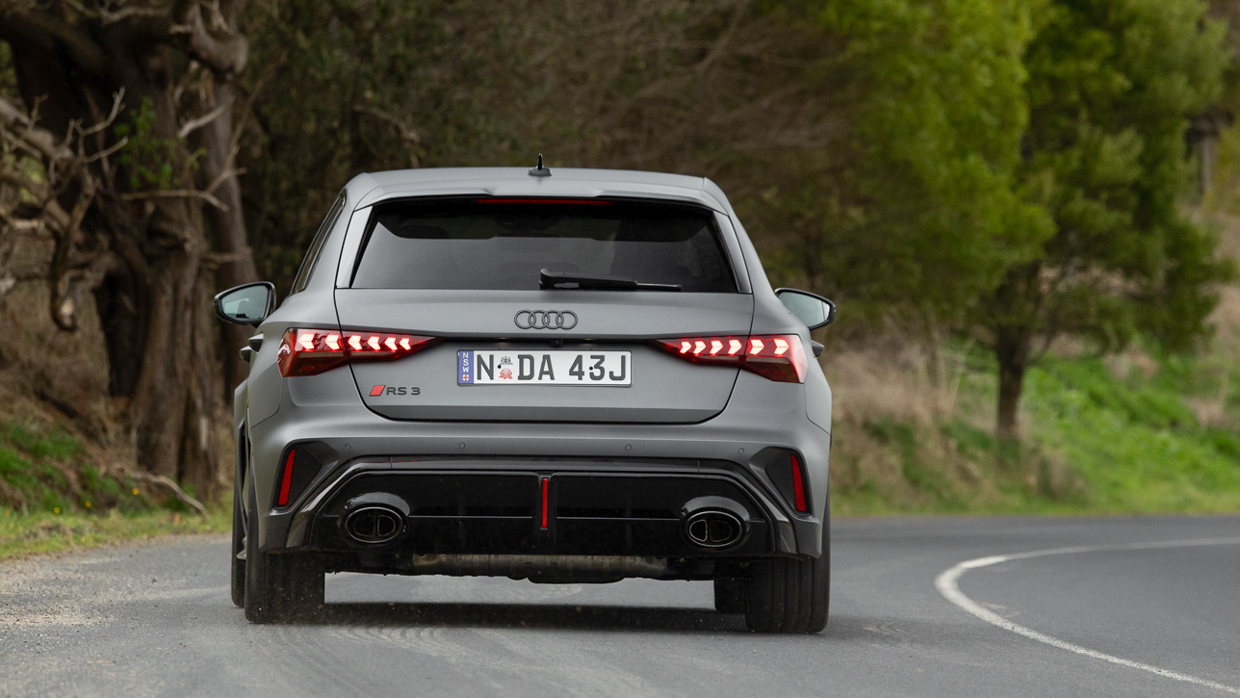
There are brief glimpses of the RS3’s economy car underpinnings, such as the intrusive tyre roar heard on the highway and the rock-hard door tops where many may want to rest their arm, which do make the RS3 a slightly disappointing cruiser.
Considering the short wheelbase of the RS3, the adaptive dampers provide an impressive performance in less-than-ideal conditions. While not infallible to larger hits, the RS3 disperses the vast majority of bumps without issue, including mid-corner imperfections that would send lesser cars understeering out of their lane.
The result is a sports car that can hit a confident flow on country roads, though we’d advise keeping the drive mode set to ‘Auto’, as this keeps the dampers in comfort mode while keeping the engine properly alive. It’s something you can also dial in with the ‘Individual’ setting.
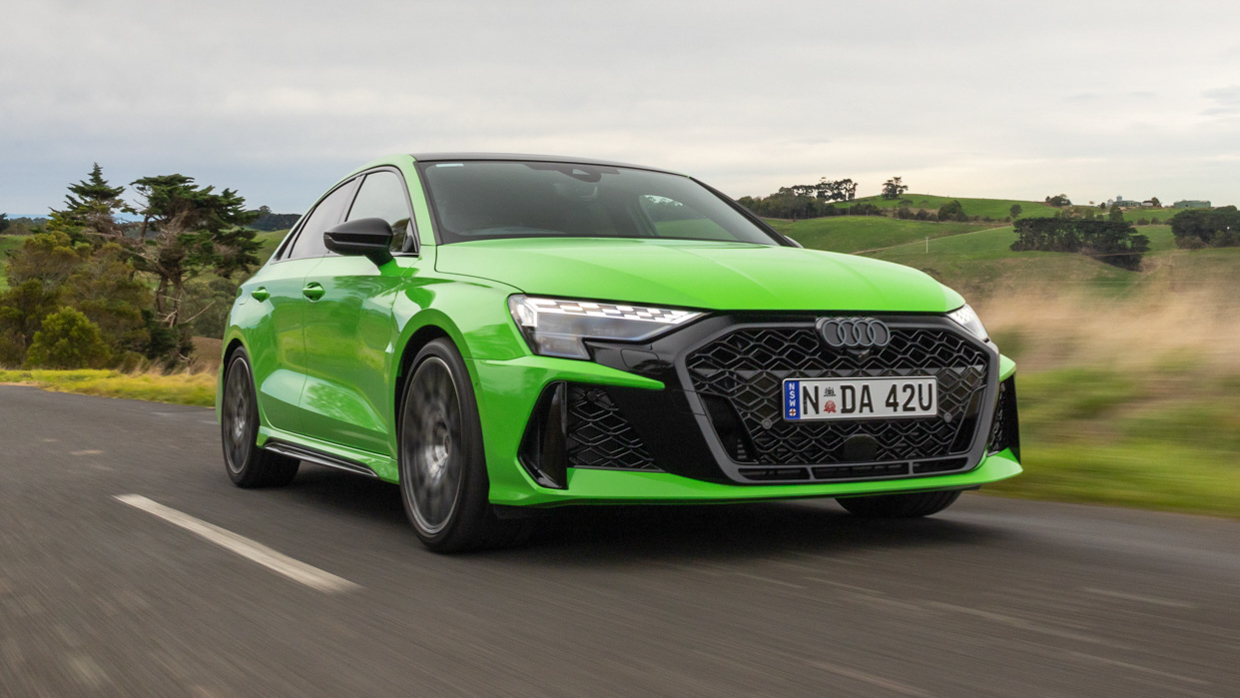
Dynamic mode is simply too firm, uncomfortable for those on board, and ultimately detrimental to the RS3’s driving performance on country roads. This mode is better left for our next destination, at the track.
Bryant Park Hillclimb Circuit, better known as Haunted Hills, is a tight and technical circuit well-suited to the RS3’s small yet punchy demeanour.
Look at the RS3 dead-on and you’ll notice the 68mm wider front track, which provides a clue as to its front-lead dynamics. Although its tail-happy nature is still accessible with RS Torque Rear mode and to a lesser degree, Dynamic mode, we set the RS3 to RS Performance mode for a more neutral handling balance.
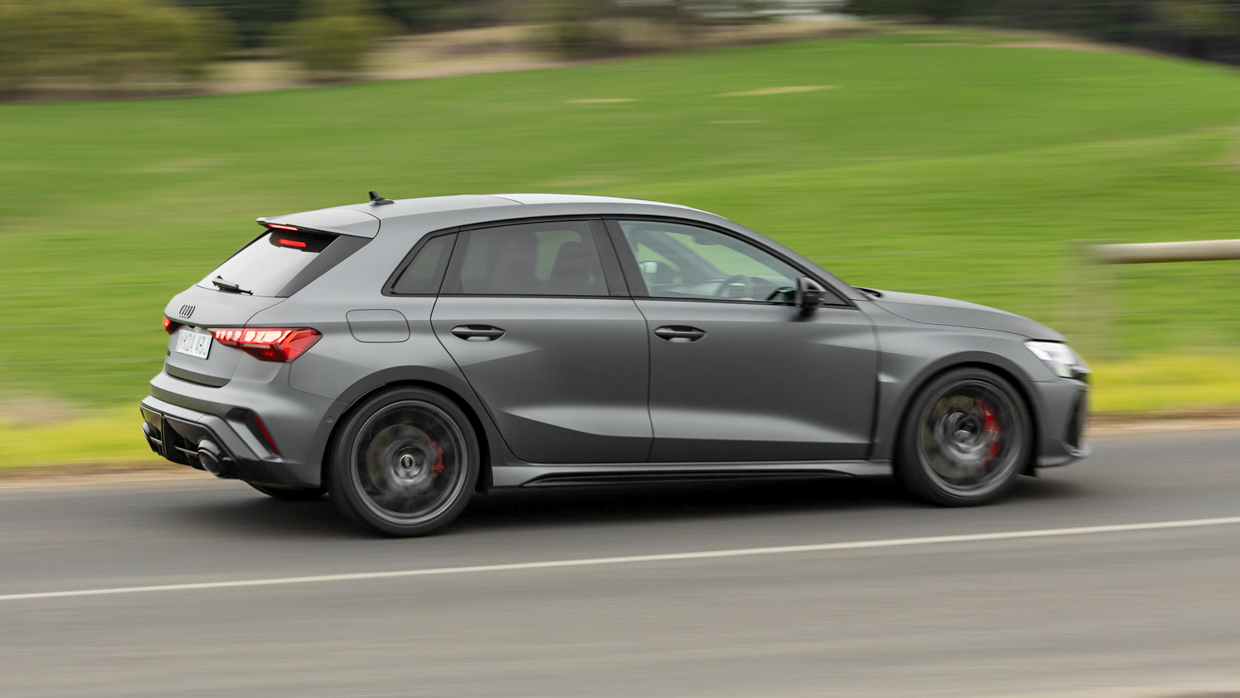
Recent tuning has increased the engagement of the rear differential to improve maneuverability, helping the RS3 wipe seven seconds off its time at the Nordschleife when compared to the pre-facelift version.
In practice, the engagement of the individual rear wheels, say for example the rear left when you’re turning right, feels smooth and helpful, though perhaps a little unnerving the first time around.
The steering feel is well-weighted across the driving modes, with engineers resisting the urge to make the wheel overly heavy in the performance modes. The progressive steering rack was also of huge benefit on a tight circuit.
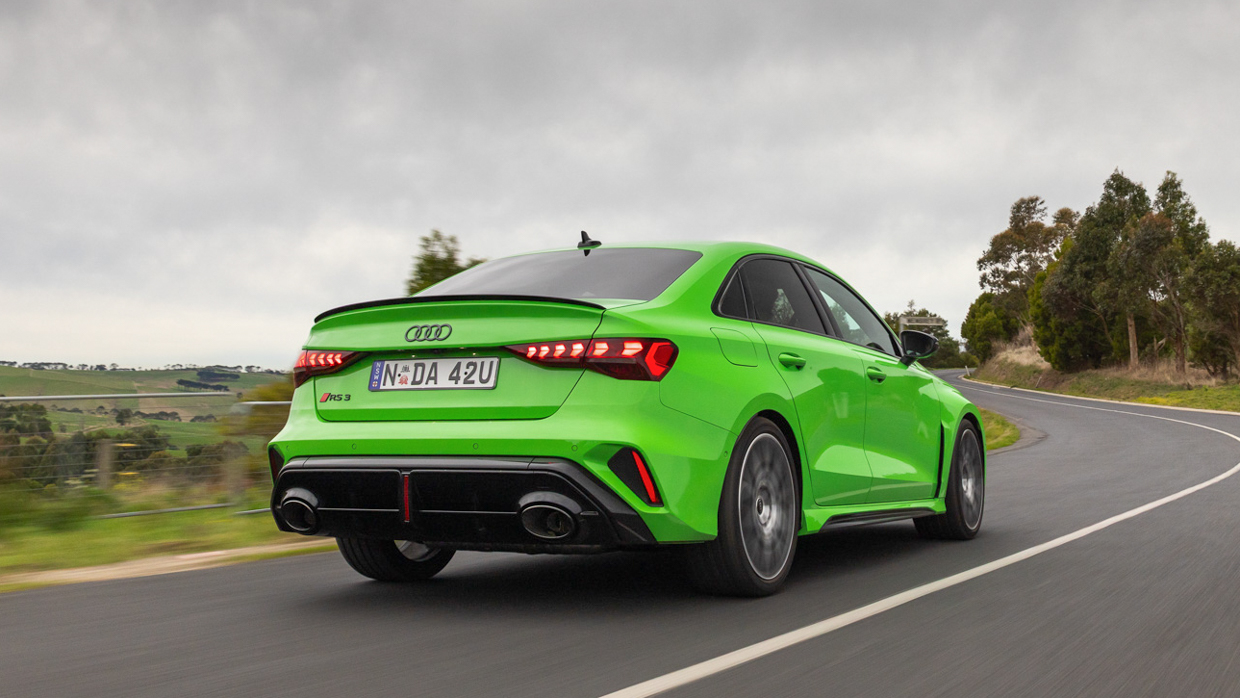
Braking performance was similarly impressive on track, with good feel and progression to the pedal.
Standard steel brakes are six-piston calipers with 374mm rotors up front, with single-piston and 310Nm rotors in the rear. Going for the ceramic option increases the rotor to 380mm, but the rears are the same size.
Optional ceramics offer a 10kg saving of crucial unsprung mass and don’t come with any noticeable driveability downsides. Given the increased durability qualities of ceramics, they’re a worthwhile investment if you plan to track your RS3 regularly.
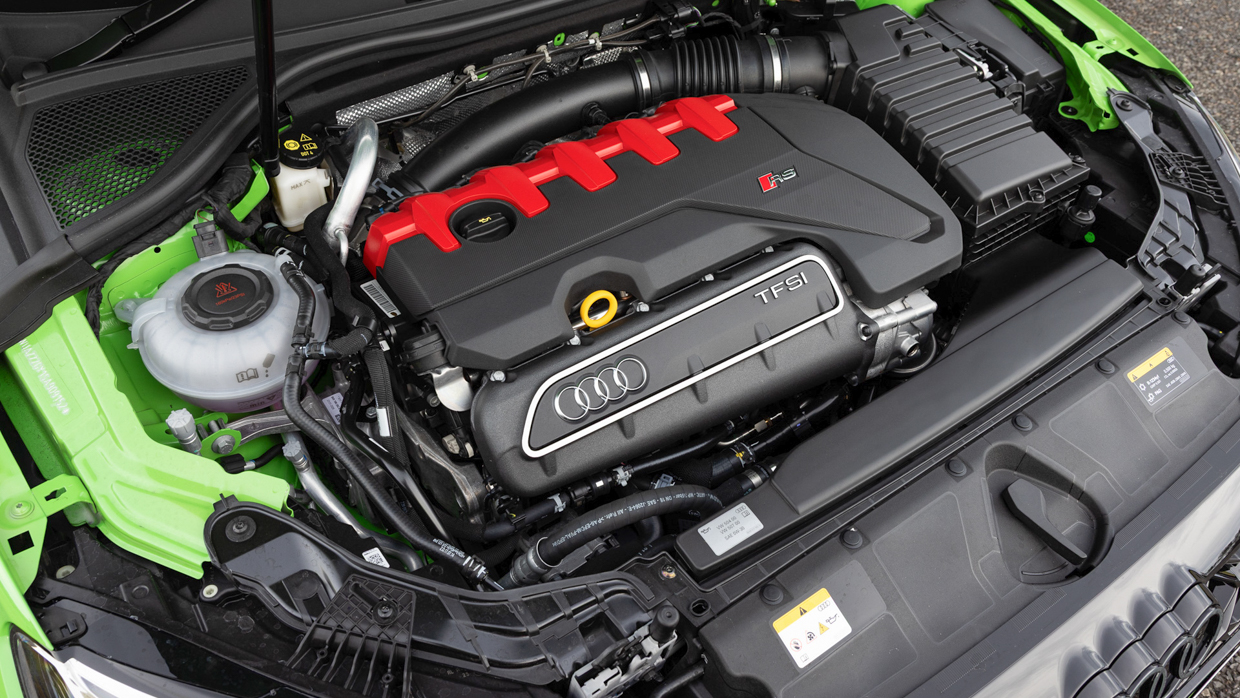
Although a tight circuit, there was just enough space to wring out the RPMs of the 2.5-litre monster and bask in its glorious, and now wholly unique soundtrack. Audi dealers would do well to base their locations directly next to a highway on-ramp if they want to shift more RS3s.
Despite the turbocharging, its 294kW power figure is available at a relatively high, and yet rewarding, 5600-7000 rpm, picking up right where the 500Nm torque peak tapers off from a low of 2250 to 5600 rpm.
There’s been no improvement to the 0-100km/h time, which remains the quickest in class at 3.8 seconds (versus 3.9 sec for the AMG A45 S). Top speed is restricted to 250km/h, though this can be increased to 290km/h upon buyer request.
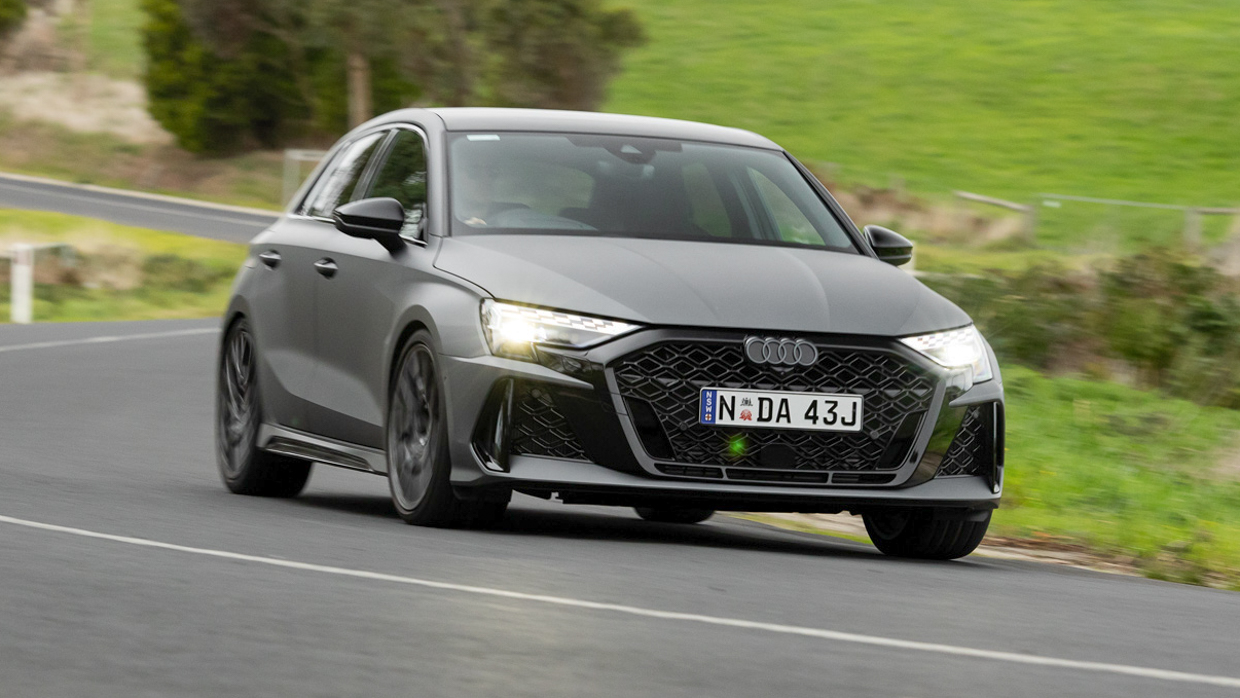
Special and yet highly functional, the five-pot provides strong and consistent force through the snappy seven-speed auto, though we do wish the paddles on either side of the wheel were just a tiny bit larger.
It’s not the only ergonomic quirk we noticed on track, as a distinct lack of padding on the centre tunnel began to wear thin on our left knee after a few hard laps. Perhaps it’s time to head inside.
Featuring the same fundamental design but with a few key upgrades, the RS3’s interior remains a functional but not flawless space.
The new steering wheel design, shared with new models like the Q4 E-tron, features a sleek look with a flat top and bottom – a saving grace for the thick-thighed among us.
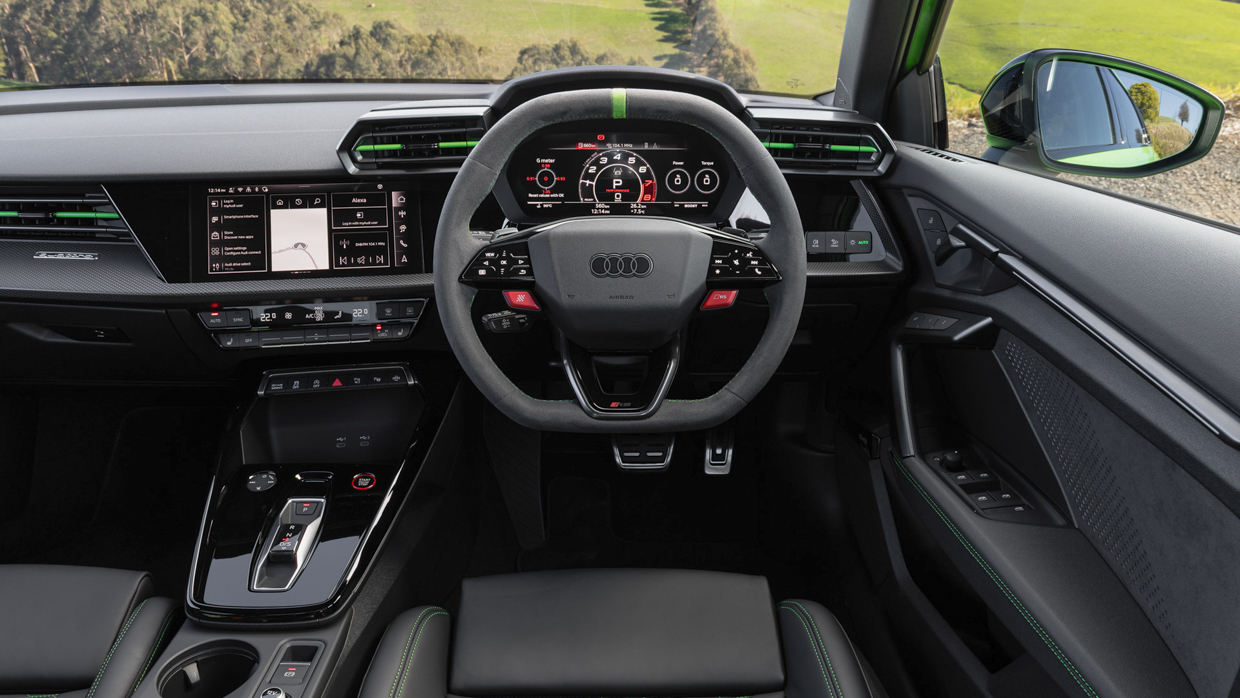
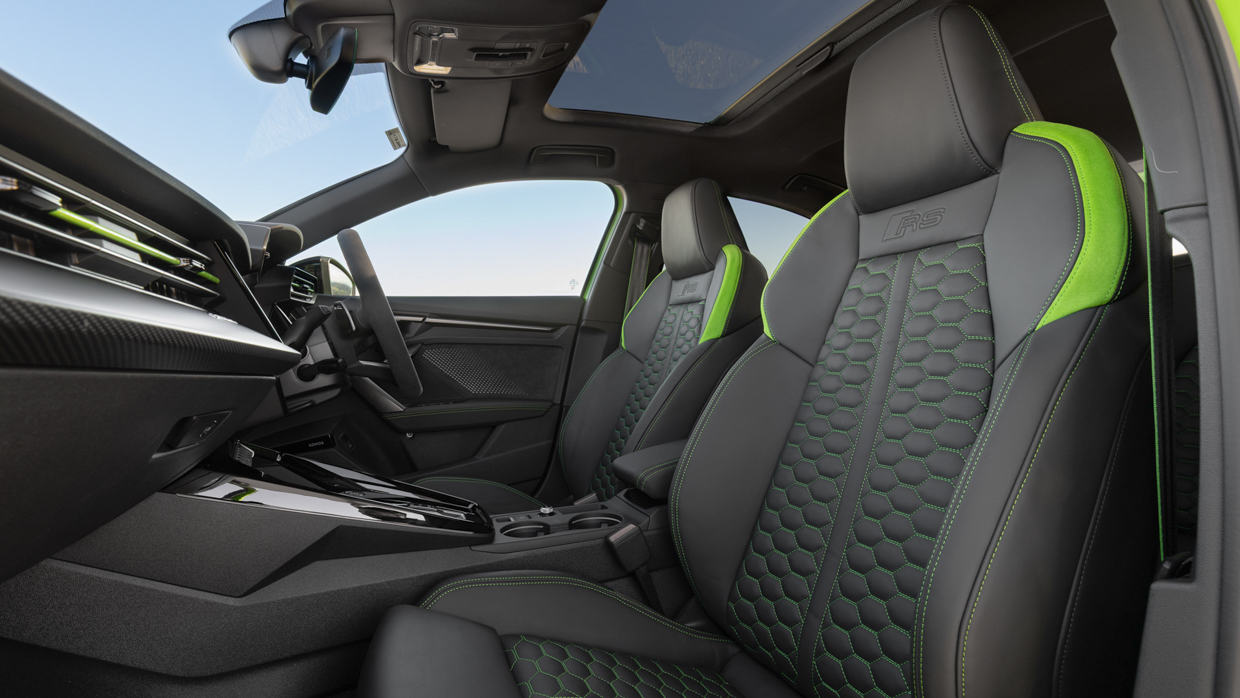
Haptic buttons in place of the old scroll wheels and clicky buttons do feel like a step back in terms of usability, as we noted a few accidental presses of adjacent buttons. The thin rim makes for a pleasant holding experience across a greater range of hand sizes, especially compared to the arguably inflated wheel of the BMW 2 Series.
Material choice is mixed inside the cabin, with quality leather across the seats and steering wheel but the new shifter design is surrounded by gloss black plastic and those rock-hard door tops we mentioned earlier are a disappointment.
The seats themselves are supportive and highly configurable to a range of body styles, with a massage function if you start to feel sore on a long drive.
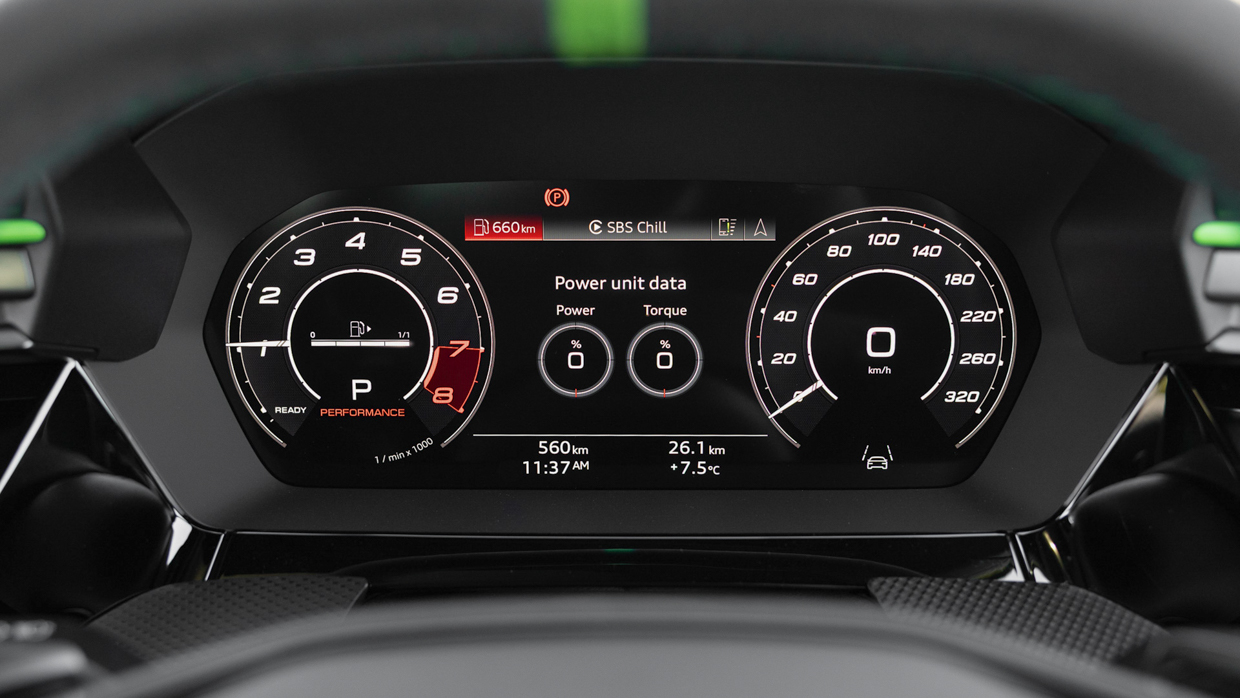
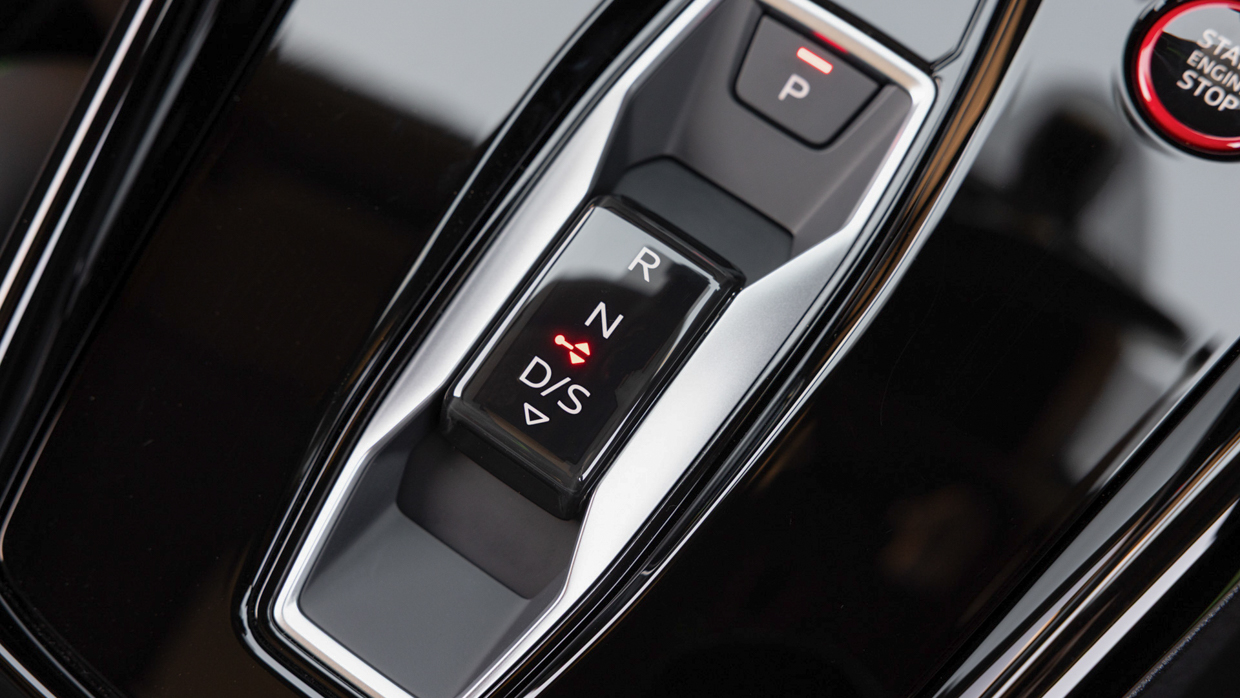
Technology is a strong point, with a list of impressive modern equipment that also functions well in practice thanks to good user interface design and complementary physical buttons for functions such as climate control.
The 12.3-inch digital driver’s display has received some updated designs more suitable for track work, making it easier to monitor your temperatures and times. It’s assisted by a crisp head-up display in helping drivers keep an eye on their speed.
A 10.1-inch multimedia screen sits in the centre of the dash and works well in practice, with wireless Apple CarPlay and Android Auto paired nicely with a wireless phone charger.

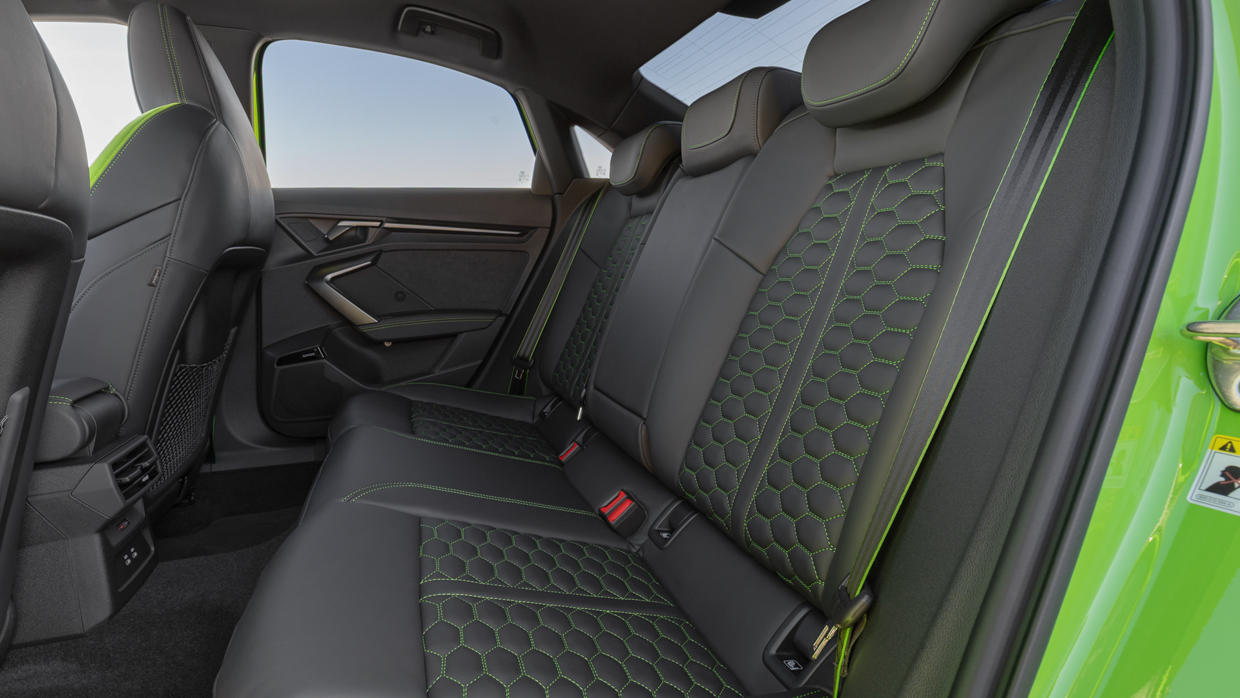
The only genuine disappointment of the tech ensemble is the 15-speaker Sonos sound system, which replaces the Bang & Olufsen system due to a contract change within Audi. After testing out tunes in multiple RS3s, we found the Sono system felt flat, muffled and uninspiring.
Being a compact car, the RS3 doesn’t offer an abundance of space in the second row but it is respectable for the segment. Sitting behind our own driving position at 182cm tall, our knees felt snug but not jammed against the seat in front.
Headroom is slightly better in the Sportback but the sedan makes up for it by having a larger 321L boot on paper, versus 282L in the five-door. Though, many will argue the practicality of a hatch is vastly superior for carrying larger items.
As is often the case with high-performance vehicles in a broader range, no ANCAP rating covers the RS3. Five stars were officially awarded to front-wheel-drive variants of the A3 in 2020, back when the current generation was first released, though crash characteristics don’t directly translate to RS3.
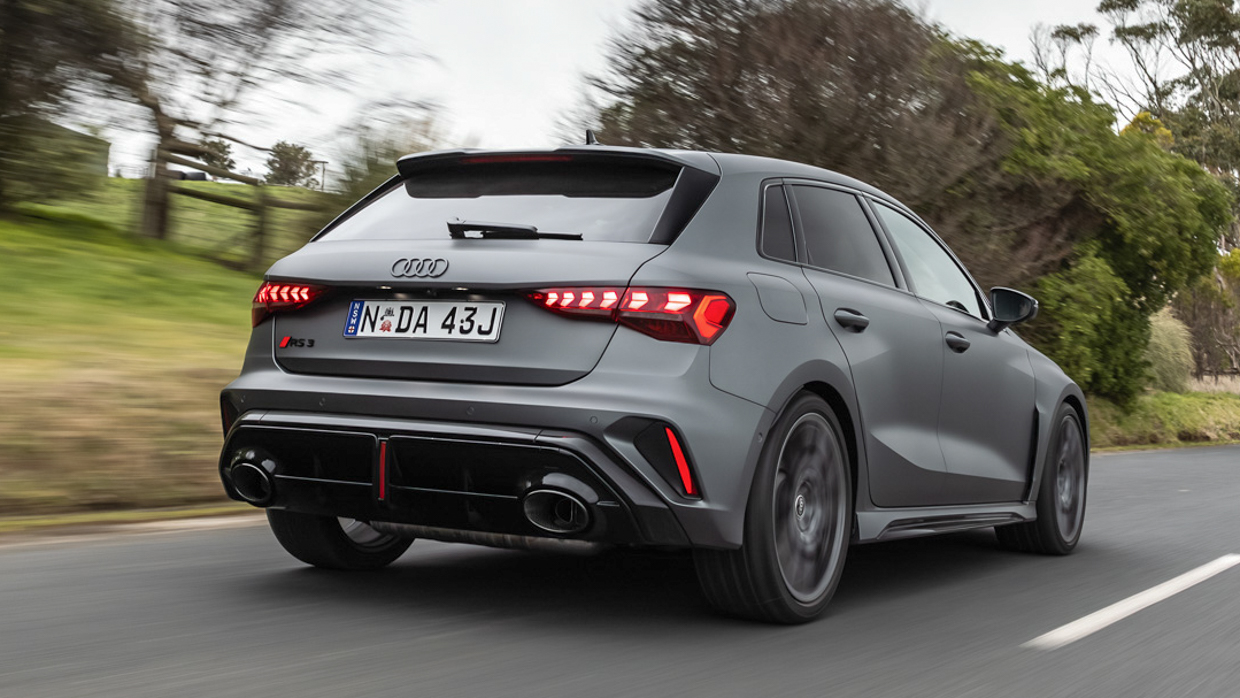
In terms of safety equipment, the RS3 is fitted with the following:
In practice, we found the tuning of these active safety systems to be satisfactory. Lane keep assist can be overly intrusive, but this is easily disabled via a button on the end of the indicator stalk.
The driver monitoring system, designed to keep an eye out for distraction and fatigue, is also appropriately calibrated for real-world use.
Those looking to upgrade from a four-cylinder performance car might expect the five-pot to be a bit of a drinker but our initial testing of the updated RS3 revealed otherwise.
On straight, 100km/h highway stretches, we clocked an indicated 6.2L/100km, this climbed to 8.0L/100km on country roads where speeds and conditions varied, and quickly north of 11L/100km once we hit the track.
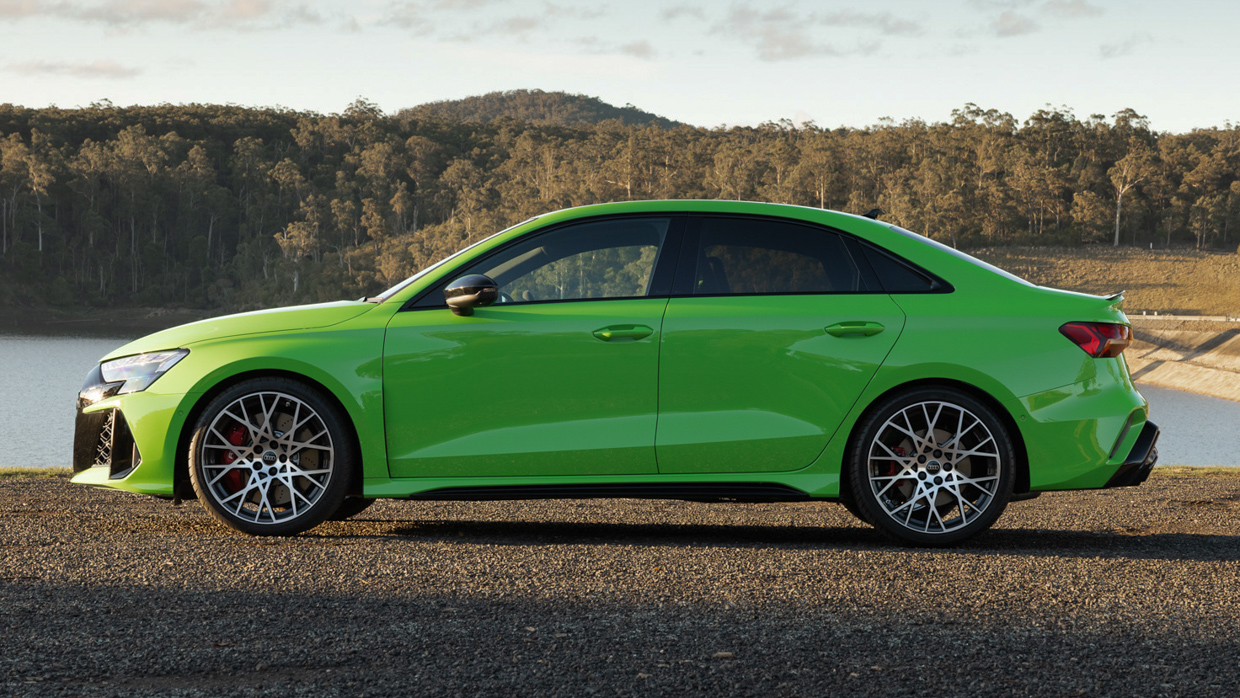
The official combined fuel consumption figure is 8.3L/100km for the Sportback and 8.2L/100km for the sedan, both requiring 98 octane fuel.
Audi offers a five-year prepaid service plan for a cost of $4010, with surprisingly generous distance intervals of 15,000km, or every 12 months. If you’re hitting the track regularly, it would be wise to budget for more than just the standard visit to keep on top of wear and tear.
Warranty is the industry standard five-year, unlimited-kilometre coverage.
With no gains to engine outputs or acceleration figures and a near five-figure price rise, Audi might be testing some of its repeat buyers with the latest RS3 update, at a time when the S3 has recently narrowed the power gap to under 50kW and adopted the grin-inducing torque-split rear differential for $26,000 less.
That said, the RS3 still remains $18K more affordable than its only genuine rival in the Merc A45 S and has made some genuine steps forward in terms of pace with the calibration upgrades of its all-wheel-drive system.
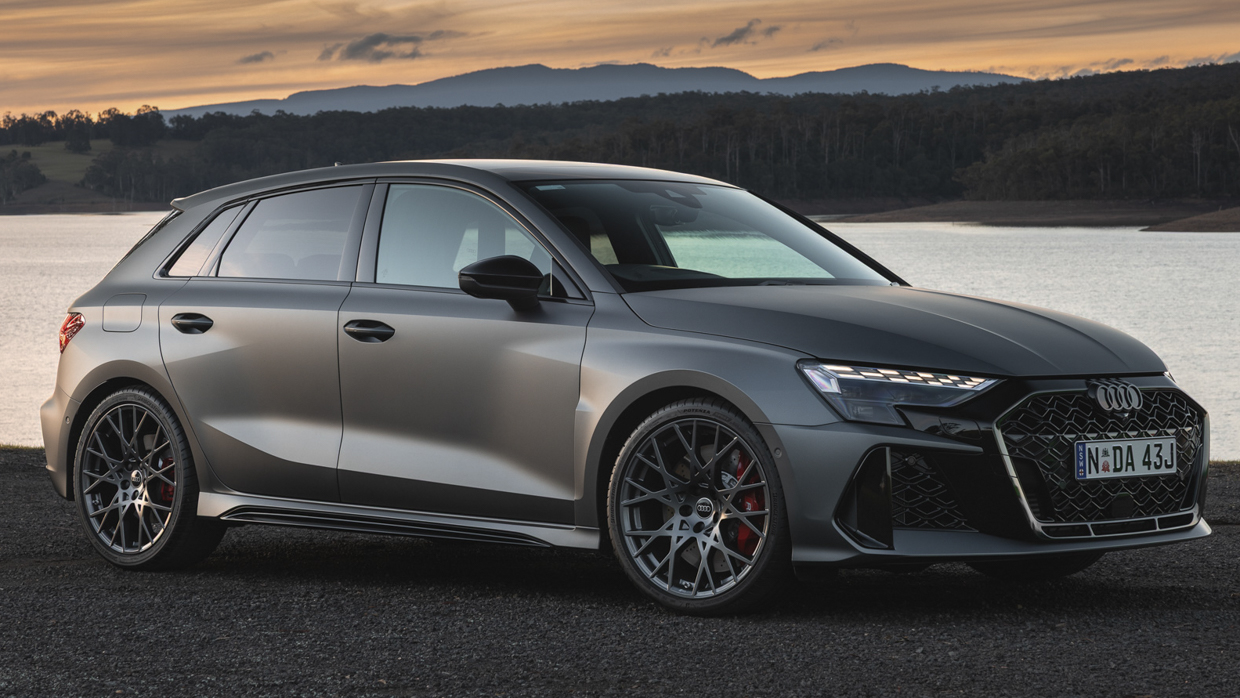
The breadth of ability of the compact and practical RS3 also makes it easier to justify than other six-figure sports cars, when it’s as easy to send sideways as it is to park in the city.
There’s no telling how much longer the RS3 will last in its five-cylinder form, but what is clear is that it remains an incredible machine with a long list of buyers in Australia, and it’s not about to get any cheaper if you wait.
Key specs (as tested)
About Chasing cars
Chasing Cars reviews are 100% independent.
Because we are powered by Budget Direct Insurance, we don’t receive advertising or sales revenue from car manufacturers.
We’re truly independent – giving you Australia’s best car reviews.
The estimate provided does not take into account your personal circumstances but is intended to give a general indication of the cost of insurance, in order to obtain a complete quote, please visit www.budgetdirect.com.au. Estimate includes 15%^ online discount.
^Conditions Apply
Budget Direct Insurance arranged by Auto & General Services Pty Ltd ACN 003 617 909(AGS) AFSL 241 411, for and on behalf of the insurer, Auto & General Insurance Company Limited(ABN 42 111 586 353, AFSL 285 571).Because we don’t know your financial needs, we can’t advise you if this insurance will suit you. You should consider your needs and the Product Disclosure Statement before making a decision to buy insurance. Terms and conditions apply.
Indicative quote based on assumptions including postcode , 40 year old male with no offences, licence suspensions or claims in the last 5 years, a NCD Rating 1 and no younger drivers listed. White car, driven up to 10,000kms a year, unfinanced, with no modifications, factory options and/or non-standard accessories, private use only and garaged at night.
^Online Discounts Terms & Conditions
1. Discounts apply to the premium paid for a new Budget Direct Gold Comprehensive Car Insurance, Third Party Property Only or Third Party Property, Fire & Theft Insurance policy initiated online on or after 29 March 2017. Discounts do not apply to optional Roadside Assistance.
2. Discounts do not apply to any renewal offer of insurance.
3. Discounts only apply to the insurance portion of the premium. Discounts are applied before government charges, taxes, levies and fees, including instalment processing fees (as applicable). The full extent of discounts may therefore be impacted.
4. We reserve the right to change the offer without notice.